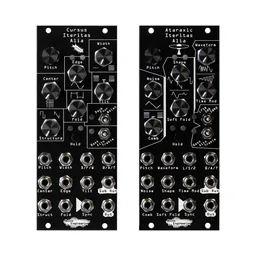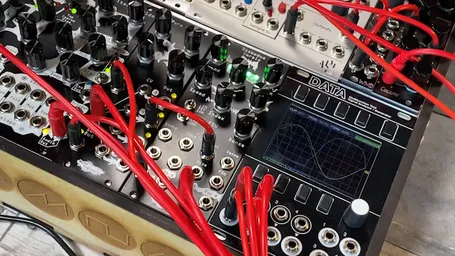Ataraxic Iteritas is the newest member of the Iteritas family and ships Monday, October 22. Preorders open this Friday! This week on the blog, we’re introducing AI and giving you a deeper look into the bits (so to speak) that make AI tick, bleep, and bloop.
Ataraxic Iteritas has been in the works for a long time. It was inspired by the Ataraxic Translatron, which was our first module, released way back in 2013. AI has three modes based on different bit tables shaped via variable interpolation that are then scrolled through, amplitude modulated, folded, and distorted by the CV-controllable front panel controls. Aggressive, deeply subby, droney, and digital. Guaranteed to make the fax machine jealous.
Ataraxic History
It’s hard to really understand the AI without a little backstory. Back in 2013, we were still deeply ensconced in our previous lives, Stephen as an audio engineer in the games industry and Kris as a field biologist/biology professor. When our friend and Stephen’s co-worker Shawn turned up at the office one day with his sparkly new modular setup, Stephen immediately started analyzing and critiquing the circuits. Shawn, tired of Stephen’s bluster, called his bluff, and challenged him to create his own damn module. Shawn really wanted one that would make the sounds of classic 8-bit video games. Stephen came home that weekend and while Kris biologized, he made the first prototype.

The first was not the last prototype, of course, but it started the journey (read more in the AT manual).
At the core, Ataraxic Translatron is a 16-bit Linear Feedback Shift Register with adjustable taps. It’s a simple module with simple controls.
XMOS comes into the picture
As Stephen’s interest in making modules grew, he explored other IC options. Each provided tradeoffs -- computational speed vs cost vs a host of other parameters. As he started to develop the Iteritas modules, he knew he couldn’t compromise on computational power. At the same time, cost had to be a consideration -- a chip that was fast but prohibitively expensive would mean that the module would be priced out of reach. We bounced these ideas around a bit and they, in large part, drove the selection of the chip that is the backbone of the whole Iteritas line.
Stephen does all the firmware development in NE. He initially developed the Basilimus Iteritas on the Iteritas platform and at that time, back in 2014-ish we we thought we were close to maxing out the capacity of the chip. And then came the LI, and the Alter. And he pulled more out of it. And then the CI, LIP, and the Manis, the most technically difficult one yet. Practice does make you better it seems… Usu Perfectionem Producat
Genesis of the AI
Once the Iteritas platform was well defined, we both dreamed of finding a way to put the Ataraxic on that architecture and giving it more controls, but other things kept getting in the way. This summer, we decided the time was right to make that happen.
Each Iteritas is slightly different so we started with the Manis Iteritas hardware with the encoder for tuning (push and turn for coarse tuning, default is fine). But we wanted this one to be a free-running oscillator like the original, so we pulled off the hit button. And then we started pondering what it should sound like. Right off the bat, we knew it would take some work, since the original AT was based on square waves. The AT is tonally interesting and fun but square waves can be difficult to manipulate (fold a square wave and, well…).
So we knew the AI wouldn’t be as simple as mapping the AT to the BIA controls, say. There would have to be some crazy manipulation happening too. Beyond that, we knew some sort of Fold was an obvious one since it’s on every Iteritas in some form and because awesome. We ended up with a soft fold: gain controls the fold amount, giving an asymmetry to the fold. It works well with simple waveforms.

But what else? Early versions included “Jitter” which just wasn’t cool by itself and pretty quickly got rolled into the Noise knob. An obvious conclusion then was that AI really needed a filter. We talked about the LPF that was on the Manis, but we were back up against that wall of maxing out the chip.
Enter the comb filter, a computationally cheap and easy filter to implement. Stephen threw some code together and we knew we had a winner.
There were other computational struggles on this one; feature updates would lead to 180-degree out-of-phase waveforms being summed together (that means no sound) at certain knob combinations. This sort of thing is common in development, but it took some clever workarounds to get all the kinks out. I mean, maybe total phase cancellation could be interesting in a module, just not in random spots!
Another Iteritas platform standard is three different modes for more sonic joys. For the AI the first mode is a direct descendent of the AT, LFSR, or Linear Feedback Shift Register. The core synthesis is similar, but you won’t get the exact same tones out of this beast as you do the AT. This is due in part to the massively different tonal control on AI, but also to slightly different octave shifting we did in the waveforms on AI.
The other two modes are SQR and SQR2. In SQR mode, AI amplitude-modulates a square wave by the harmonic series. Turn the waveform knob to blend between harmonics. SQR2 mode is similar but the modulation harmonic goes up by octaves to get massive pitch differences between the first and second strongest harmonics.
We quickly also realized that because of their relationship, AT is a hella good modulation source for AI. And vice versa. (ATs out there, don’t feel scared! You still have utility!)
The AI ended up being possibly our most aggressive-sounding oscillator. I’m not sure we thought it would be from the start, but it fits into this niche pretty well. It’s dirty and digital and sometimes unrefined. But like Manis Iteritas, it’s also capable of pretty things. (H/T to friend of NE Matt Lange [who is part of the reason the Manis Iteritas exists, and who is no stranger to aggressive oscillators]. Matt quickly recorded a strikingly beautiful piece out of it, proving this point for us).
We got to play with AI a lot over the past few months as we developed it, and it’s become a real staple in our cases. We use it for just about everything! It can be percussive with a VCA on it, it can be a good bass, drones, swells, metallic anything... it can even be coaxed into a lead for the right piece. Friends we’ve shown it to have made it into industrial glory, techno beastiness, and lovely leads after a quick overview of the controls. We’re really happy with how flexible this one came out and we hope you enjoy the AI as much as we do!






